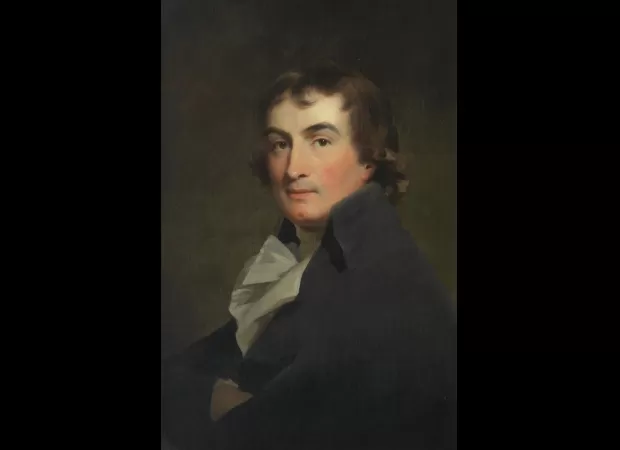10 significant Scottish artists to be familiar with.
Learn about 10 influential Scottish artists before Bonhams Scottish Art auction on May 15, including renowned portrait painter Henry Raeburn.

As the date of Bonhams Scottish Art auction draws near, anticipation is high for the impressive collection of artwork that will be on display in Edinburgh. May Matthews, the specialist and head of the sale, is excited to introduce ten of Scotland's most influential artists from the last 250 years.
Sir Henry Raeburn is perhaps the most well-known painter in Scotland. His career as a portrait painter flourished in the late 18th and early 19th centuries. Despite being self-taught, Raeburn's marriage to a wealthy widow allowed him to travel and study abroad. His talent was recognized by King George IV, who appointed him as Portrait Painter in Scotland. Raeburn's impressive list of subjects includes prominent figures such as Sir Walter Scott. In addition to his success as an artist, he was also elected as president of the Society of Artists in Edinburgh and received a knighthood in 1822.
Samuel John Peploe is considered the leader of the Scottish Colourists, a group of four painters known for their bold and vibrant use of color. Peploe's work is heavily influenced by French Modern masters like Manet and Cézanne. He is particularly known for his still lifes and his portrayal of the Hebridean landscape, which he captured during his visits to the island of Iona.
George Leslie Hunter stands out among the Colourists as he has no connection to Edinburgh and received no formal training. The self-taught artist returned to Scotland during World War I and found success with a solo exhibition in Glasgow. Hunter then traveled throughout Europe, experimenting with different styles and media. During a break from his travels, he settled in Fife and produced paintings inspired by the stunning views of Loch Lomond.
John Duncan Fergusson, another member of the Colourists, was heavily influenced by the Impressionists and later the Fauvists. He moved to Paris in 1907 and became friends with renowned artists such as Matisse and Picasso. Like many French artists of the time, Fergusson began to focus on the female nude as a recurring subject in his work. With the onset of World War II, he returned to Glasgow with his wife and founded the New Art Club. Fergusson was the first president of this club, which later gave rise to the New Scottish Group of painters.
Francis Cadell, like many of his fellow Colourists, studied in Paris and drew inspiration from the artistic movements he encountered there. However, it was his visits to the island of Iona that had the greatest impact on his work. Cadell first visited in 1912 and returned every summer thereafter, often accompanied by other artists. He was also skilled in sketching and produced powerful brush and ink sketches of army life before serving in World War I.
Anne Redpath was a trailblazer for female artists, attending the Edinburgh College of Art in 1913 and continuing her studies in France. Her work showed clear influences from Post-Impressionist artists like Matisse. Redpath's paintings ranged from domestic scenes to still lifes, portraits, and landscapes from her travels. In 1944, she was appointed as the president of the Scottish Society of Women Artists and became the first woman elected to the Royal Scottish Academy in 1952.
Dame Elizabeth Blackadder, born in Falkirk, developed an early interest in nature. She studied in Edinburgh and traveled around Europe thanks to scholarships. Her first solo exhibition was held in Edinburgh in 1959, and she later became a lecturer at Edinburgh College of Art. Blackadder's work is characterized by its strong links to Matisse and includes still lifes, portraits, and landscapes.
Joan Eardley, who was born in Sussex but moved to Scotland as a child, studied at the Glasgow School of Art. She was drawn to peasant life in Italy and France during her travels and later set up her studio in the tenement blocks of Glasgow, where she captured the essence of post-war childhood in her paintings. In 1951, Eardley visited the fishing village of Catterline and eventually purchased a house there. The wild and expansive landscape of the North Sea had a profound impact on her work.
John Byrne, born on a rough housing estate in Paisley, is known for his inventive artwork. Despite facing rejection from the University of Edinburgh's Fine Arts program, he launched his career with a successful exhibition in London in the late 1960s. Byrne also gained recognition for his work in theatre and television, including the widely acclaimed play The Slab Boys.
Finally, Jack Vettriano, born Jack Hoggan in Fife, is a self-made artist who taught himself to paint while working odd jobs. Despite being rejected from art school, Vettriano's paintings gained popularity and have become ubiquitous in Britain. Critics may deride his style and subject matter, but his commercial success remains unshaken.






